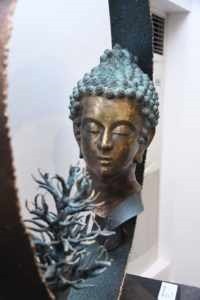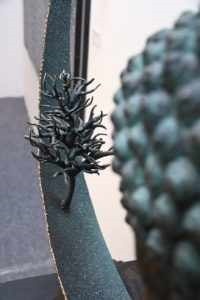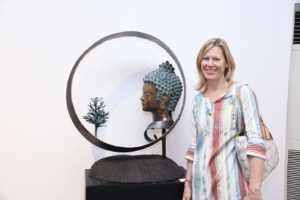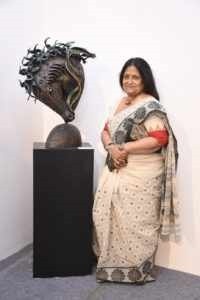In a corner at Bikaner House at the Art & Soul, Art of India exhibition is a stellar sculpture of a horse’s head.Entitled Mustang Sally it is a mesmerising portrait of a horse in the hands of a brilliant architect turned sculptor Arzan Khambatta.
Khambhatta a Mumbai dweller has been creating sculptures with scrap metal and this one is a beauty to behold. Khambhatta is one who amalgamates his artistic pursuits with his sense of social responsibilities. Stylistically, he chooses to apply the techniques of Western Realism to modern media, widening the pictorial possibilities created by a painterly lexicon. Khambatta has two sculptures in this show by Times of India.The second work is a small Buddha head with a sapling. Created in bronze this one too is a work that draws in the viewer’s gaze.
Article by Uma Nair | TOI
Translating metal
To him, the form that he translates in metal is the most crucial aspect of creating his lingua franca and sculpture for him is not an independent element seeking its own amusement and prominence. Instead, sculpture for him is one of the tools of expression like charcoal sketches and oil paintings. Unbounded by the formalities of the medium he uses we see a remarkable attention to detail, the marble for the eye, the twisted metal for the mane and Khambhatta’s ultimate artistic vision that exhibits the spirit by freely utilizing and mixing all the Western and oriental technical characteristics and materials.
Rarity of subject
When you stand and study both these images you know that of the traditional techniques, one should preserve the outstanding ones, inherit the disappearing ones, change the inadequate ones, and infuse the adaptable world techniques into one’s work.Khambatta treats both subjects with great sensitivity and fervour.The Buddha head is one of grace and gravitas.
Savouring beauty within
This Buddha is a work to savour and contemplate upon.The sapling is a testimony to Buddha’s love for the bamboo grove he would inhabit for meditation.What makes for great quality in a Buddhist sculpture is based on a number of things, including the stylistic modelling of the figure, the rarity of the subject, and the skill of the sculptor. At the end of the day, people all over the world, are buying Buddhist sculptures because they are beautiful and well made.
Khambatta says: ” The Buddha. Is a bronze cast work showing him look into the distance. The simplistic tree ascertains “life”
The divine and life itself form the circle of life.”
This work brings alive many facets. Many collectors are drawn to the religious components of the objects, others appreciate the rich history of more than 2,000 years of Buddhist art. This sculpture endorses earlier periods, it recalls how artisans and theologians have delved deeper and deeper into the nature of Buddhism, coming up with new ways to think about the principles of Buddha’s teachings.
The resultant esoteric form, of the Buddha head reflected in the diversity of Buddhist idioms, offers countless avenues for study and appreciation.The sapling tells us that man and nature belong to the thread of harmonic existence.
Equine imagery
The second work of the horse’s head offers yet another subject for reflection. You know that Khambhatta is conscious of the symbolism that the subject carried. Arguably the beauty of horses goes hand in hand with their cultural meaning. We see that Khambhatta has also been influenced by equine images and unconsciously recalls to our minds a spanning from Paleolithic art to the Elgin marbles, paintings by Uccello and Picasso.As subject horses have always been in fashion and spawns collectors world over.
“I have always loved horses for their sheer grace and power,”says Khambatta who came for the inauguration to Delhi. ” The most aesthetic of beasts, l love crafting them in various materials. Iron, copper, wood, bronze, resin etc. the metal horse here in the show has got light blue glass eyes and I call her MUSTANG SALLY.”
The art of the horse comprises recalling horse images in art from antiquity to present day. This sculpture makes us think of how horses were often utilised for warfare and labour whereas today they are more likely to be owned for pleasure. We think of the great Tim Janis and his drone images of wild horses roaming the pastures and mountains. We are looking to get closer to animals at a time when we have actually never been more separated from them. Encouraging debate around these ideas is central to this work.
[Images: Shazid Chauhan]






